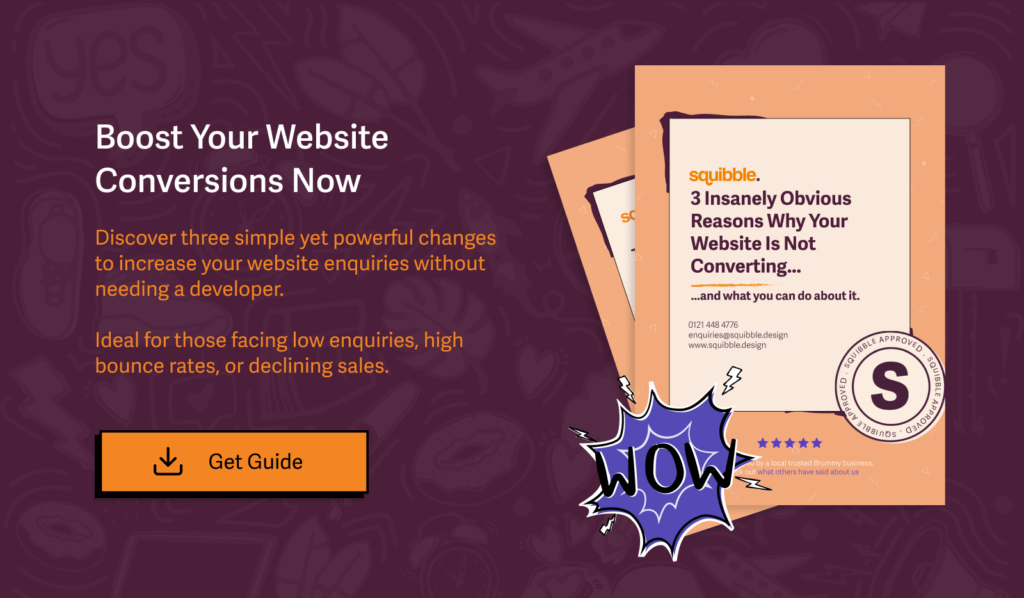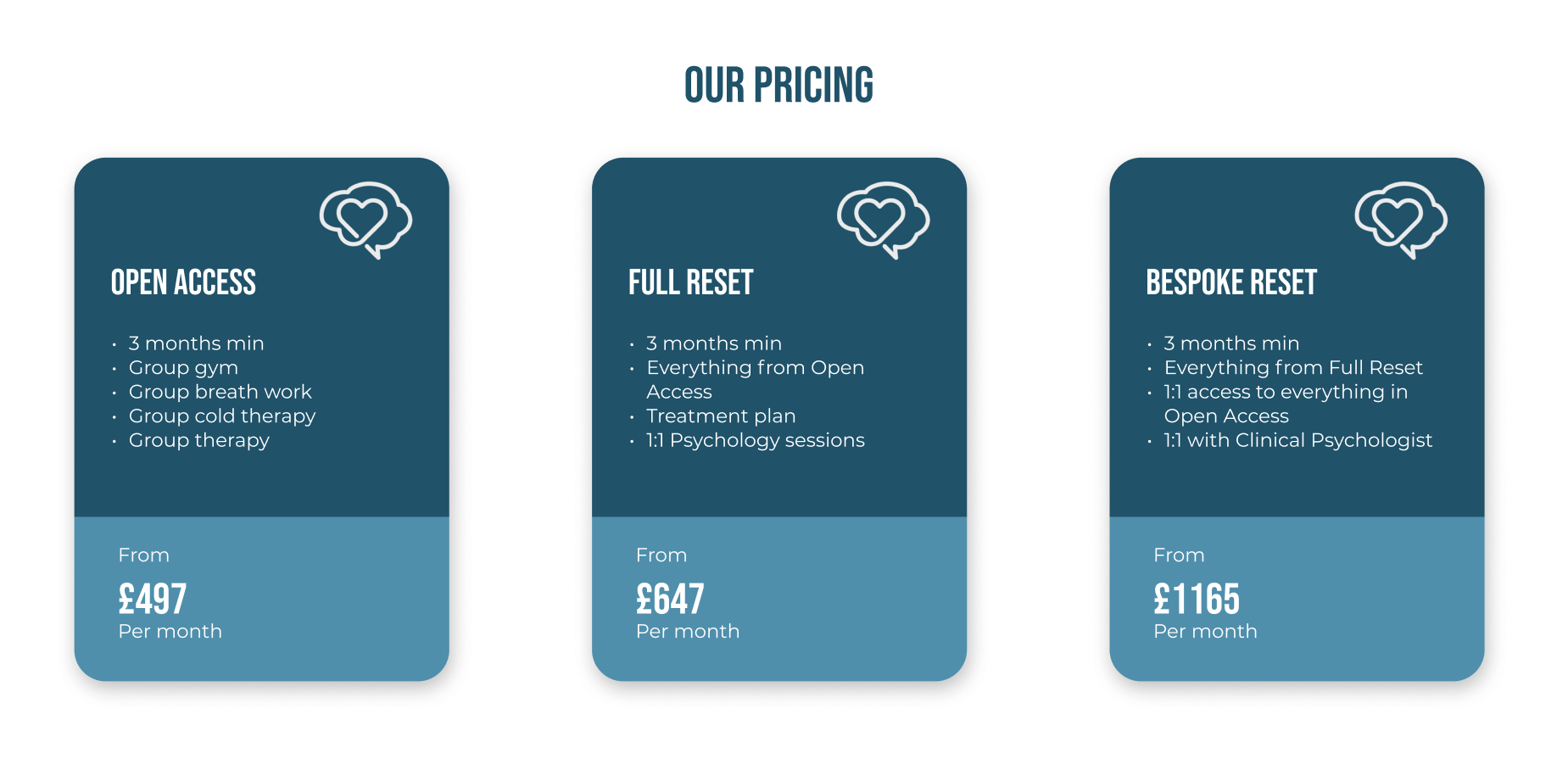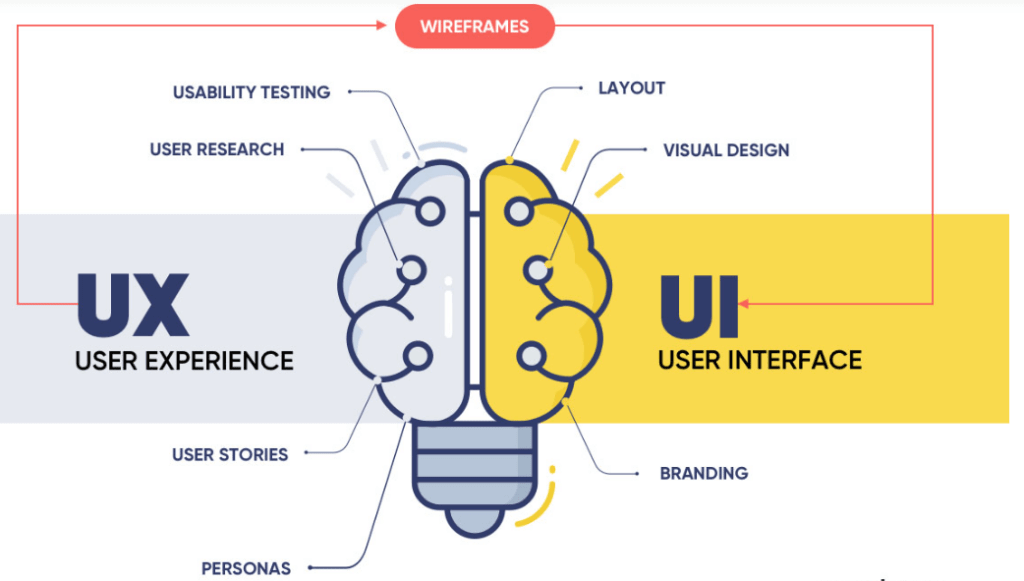Our comprehensive guide for Marketers so you can increase your conversions.
Let’s embark on a transformative journey together, where you take the reins and unlock your website’s full potential. We’re here to guide you, but the power to turn your website into a beacon that leads your business towards unparalleled growth is in your hands. If you need any help, just email us at hello@squibble.design.
Our guide is a set of tips and a strategic blueprint for high-converting B2B websites. It’s designed to empower you, the business owner, to take control of your website’s performance and drive significant growth. Building a B2B website that serves as a conversion magnet is an accomplishment that takes work, but with our strategic guidance, you can navigate this journey with confidence.
1. Unlock the Potential of Your Value Proposition
In the competitive arena of B2B sales, a well-crafted value proposition is not just a tool; it’s a game-changer that can set your business apart and attract high-value prospects. Integrating this with strategic B2B branding amplifies your market presence, ensuring that your core message resonates not only with the logical aspects of decision-making but also with the emotional factors.
The Science Behind Persuasion
Leveraging insights from behavioural psychology and market analysis, a potent value proposition addresses the 99% of B2B purchases driven by the urgent need to navigate organisational changes. It acknowledges the overwhelming nature of these changes and presents your offering as the key to unlocking a smoother, more efficient path forward. In simpler terms, think of a potent value proposition as the key reason a business would choose your product or service over others. It’s like saying, “Here’s how we can make your life easier during big changes.” Things can get chaotic when a company goes through many shifts or updates. Your value proposition promises to be the solution that helps them navigate through this mess more smoothly and efficiently, almost like a guide through a challenging journey, making sure they come out on the other side better than they started.
Crafting Your Message
Creating a compelling sales proposition begins with deep empathy and understanding your target audience’s pain points, aspirations, and decision-making processes. This involves:
- Identifying Key Pain Points: Engage in conversations with current and potential customers, mine data for insights, and employ social listening to grasp your audience’s challenges.
- Articulating Clear Benefits: Translate your features into tangible benefits. How does your product or service make life easier, enhance productivity, or drive growth for your clients?
- Differentiating Your Offer: In a market saturated with solutions, clarity on what sets you apart is crucial. Is it your technology, customer service, or an innovative approach to a common problem?
Positioning for Impact
Where and how you present your value proposition can significantly affect its effectiveness. Placing it prominently on your homepage, above the fold (the portion of a webpage that is visible without scrolling), ensures it’s the first thing visitors see, capturing their interest and encouraging them to explore further. But it’s not just about location; it’s about making an instant connection. You can turn your value proposition into a powerful magnet that attracts high-value prospects using clear, jargon-free language, engaging visuals, and compelling storytelling.

2. Make Decision-Making Easy
When navigating the intricate world of B2B purchases, attention often gravitates towards the main features of products or services. Yet, lurking in the periphery are the unsung heroes – the peripheral benefits. These hidden gems can play a crucial role in swaying the decision-making process in your favor. By illuminating these secondary advantages, you’re not just addressing what your clients need right now but also aligning with their wider ambitions and tackling their challenges head-on.
How Your Product Offers More Than Meets the Eye
Delving into the extra perks of your product or service uncovers a treasure trove of benefits that extend beyond the primary reason your clients might choose you. Here’s a glimpse into how your offering does more than just the basics:
- Making Work Easier: Imagine turning tedious tasks into a breeze. By demonstrating how your product simplifies operations, you’re showing clients the path to enhanced efficiency and reduced manual labor.
- Staying Up-to-Date: In a rapidly evolving tech landscape, your product doesn’t just keep pace; it leads the charge. Highlight its compatibility with new technologies and seamless integration into existing systems, assuring clients that you’re a partner for the future.
- Keeping Things Safe: Security isn’t just a feature; it’s a necessity. In an age where digital threats loom large, showcasing your product’s robust security measures can set you apart, providing peace of mind in a vulnerable digital world.
- Helping Them Grow: Your product or service isn’t just a tool; it’s a catalyst for expansion. Whether it’s breaking into new markets, launching innovative products, or scaling operations, you’re not just a vendor – you’re a growth partner.
By spotlighting these peripheral benefits, you’re not just selling a product; you’re offering a multi-faceted solution that caters to the holistic needs of your clients, making the decision-making process not just easy, but compelling.
Communicating the Full Spectrum of Value
The key to effectively unveiling peripheral benefits lies in strategic communication. Integrating these benefits into your marketing materials, sales conversations, and especially your website. Here’s how:
- Detail Pages and Case Studies: Use product detail pages and case studies to delve into the specifics of how your offerings have contributed to the success of similar businesses, providing concrete examples of peripheral benefits in action.
- Tailored Content: Develop content that speaks to the diverse concerns of your decision-makers, offering insights and solutions that resonate with their broader business objectives.
- Interactive Tools: Consider incorporating tools like ROI calculators or product configurators that allow prospects to visualise the potential impact of your solution on their business, including the peripheral benefits.
By expanding the focus to include peripheral benefits, you’re not just selling a product or service; you’re offering a comprehensive solution that aligns with the multifaceted needs of your B2B clients. This holistic approach makes your proposition more attractive and positions your brand as a strategic partner committed to driving overall business success.

3. Making Your Product Easy for Everyone to Use
In the digital age, where access equates to opportunity, democratising product access (making it widely available and easy to use) is a cornerstone of customer engagement and conversion. Businesses can significantly demystify their solutions by offering transparent, hands-on experiences through demos, trial periods, and explainer videos, inviting prospects into a world where their value is seen and felt.
The Golden Key of Accessibility
Making your product accessible in various formats caters to learning and decision-making styles, broadening your reach and appeal. This inclusivity in access facilitates a deeper connection between your prospects and your product, paving the way for more informed and confident purchasing decisions.
Show, Don’t Just Tell
When it comes to convincing potential customers about the value of your product or service, nothing beats giving them a firsthand look. It’s about moving beyond just talking about what you offer and actually showing them how it works and how it can make a difference. This approach not only highlights the features and benefits of your product but also builds a deeper level of trust and understanding.
Let’s dive into three effective ways to bring your product to life for your customers:
- Live Demos offer prospects a real-time, interactive platform to see your product in action, ask questions, and gauge its fit for their needs. This direct engagement is invaluable in building relationships and trust.
- Trial Periods provide a no-strings-attached experience, allowing prospects to test your solution in their own environment and at their own pace, making the value proposition personal and tangible.
- Explainer Videos are powerful tools for breaking down complex solutions into digestible, engaging content. They help quickly convey the essence and benefits of your product, captivating interest and sparking imagination about its potential impact.
Facilitating a Seamless Introduction
The process of introducing prospects to your product must be seamless and frictionless. Easy sign-up processes for trials, straightforward navigation for demos, and prominently placed explainer videos contribute to a user-friendly experience that can significantly enhance the conversion journey.

4. Building Strong Customer Relationships
In the intricate dance of B2B relationships, the music doesn’t stop at the point of sale. After-sales support plays a pivotal role in sustaining and deepening client relationships. Exceptional after-sales service reassures clients of your unwavering commitment to their success, fostering a sense of loyalty and partnership that transcends the transactional.
The Backbone of Ongoing Support
Effective after-sales support is multifaceted, addressing everything from troubleshooting and technical assistance to user training and updates. It embodies your brand’s promise to stand by your clients, ensuring their journey with your product is smooth and rewarding.
Building a Foundation of Trust
- Responsive Support Channels: Offering multiple avenues for support — through live chat, email, phone, or social media — ensures that help is readily available when your clients need it. However, they prefer.
- Proactive Problem Solving: Take action to escalate issues. Regular check-ins and updates can help you anticipate and address potential challenges before they become problems, demonstrating your proactive approach to customer care.
- Educational Resources: Beyond problem-solving, providing clients with comprehensive resources such as tutorials, webinars, and FAQs empowers them to make the most of your product, enhancing satisfaction and user competency.
Fostering a Community of Success
Engaging clients in a community where they can share experiences, insights, and feedback enriches the user experience and cultivates a collaborative environment that can lead to product improvements and innovation. This community-driven approach to after-sales support not only enhances customer loyalty but also positions your brand as a leader committed to the collective success of its users.
By prioritising transparent product access and exceptional after-sales support, businesses can forge deeper connections with their prospects and clients, transforming the customer journey into a shared path of discovery, growth, and success.

5. Use Social Proof to Improve Credibility
In the digital age, where scepticism often shadows online transactions, third-party verified social proof emerges as a beacon of trust, guiding prospects towards confident engagement with your brand. This type of validation acts as a powerful endorsement, amplifying your brand’s credibility and setting a solid foundation for prospective clients to build their trust.
The Seal of Approval
Integrating third-party verified accolades, certifications, and reviews into your digital presence does more than just decorate your website; it is a testament to your excellence, reliability, and commitment to quality. It signals to potential clients that reputable sources have rigorously evaluated and endorsed your solutions and services, offering them security and confidence in their choice.
Strategic Placement for Maximum Impact
- Showcasing Accolades and Certifications: Position these symbols of excellence where they’re most likely to be seen—on your homepage, product pages, and website’s footer. This constant visibility reminds visitors of your esteemed status throughout their browsing experience.
- Featuring Reviews and Testimonials: Curate and display powerful testimonials and reviews, especially those from well-known entities in your industry. Consider creating a dedicated section for these endorsements or integrating them into crucial conversion points on your website.
- Leveraging Trust Badges: To add an extra layer of credibility, include badges from third-party review sites, such as Trustpilot or G2. These badges are a shorthand for trust, indicating that the broader community recognises and values your offerings.
The Power of Storytelling
Utilise these social proof elements not merely as tokens of credibility but as narrative tools. Share stories behind the accolades, delve into case studies highlighted in reviews, and weave testimonials into your brand’s larger story. This approach elevates your credibility and connects with prospects emotionally, making your brand more relatable and trustworthy.

6. Mastering the Pricing Page
The journey towards conversion often culminates at the pricing page, making it one of the most critical elements of your website. A well-optimised pricing page removes barriers, clarifies your value proposition, and guides prospects towards making an informed, confident decision to purchase.
Clarity, Accessibility, and Simplicity
Ensuring that your pricing structure is straightforward and easy to understand is paramount. This transparency eliminates confusion and helps prospects evaluate your offering against their budget and needs.
Enhancing the User Experience
- Streamlined Navigation: Ensure that your pricing page is easily accessible from anywhere on your site. A clear, intuitive navigation structure prevents frustration and keeps prospects moving smoothly towards making decisions.
- Simplifying Complex Information: Use tables, bullet points, and icons to break down and present pricing information in an easily digestible format. Highlight key differences between plans to aid in comparison and decision-making.
- Personalisation and Flexibility: Where possible, offer customisable pricing options or sliders that allow prospects to tailor the offering to their needs. This empowers the buyer and demonstrates your flexibility and customer-centric approach.
Clear Calls to Action
Your pricing page should include clear, compelling calls to action (CTAs) that guide users to the following steps: purchase, contact sales for more information, or sign up for a trial. Ensure these CTAs stand out visually and are accompanied by reassuring microcopy that addresses potential concerns, such as commitment or cancellation policies.
Building Confidence at Every Step
Add social proof and reassurance elements on your pricing page, such as money-back guarantees or prominent customer support promises. These signals of trust and support can significantly lower the perceived risk, making the decision to proceed much easier for the prospect.
By meticulously crafting your pricing page to be as clear, accessible, and reassuring as possible, you create a frictionless path to conversion, encouraging prospects to take the final step with confidence.

7. The Impact of Clean UI & UX Design
In the digital realm, where attention spans are fleeting, and first impressions are lasting, the importance of clean, intuitive UI and UX design cannot be overstated. It’s the silent ambassador of your brand, speaking volumes through simplicity and functionality and guiding visitors effortlessly towards conversion.
Prioritising User-Centric Design
A user-centric approach to design focuses on creating interfaces that are accessible, intuitive, and enjoyable to use. This involves:
- Streamlining Navigation: A well-organised and logical navigation structure allows users to find the information they need without frustration, enhancing their overall experience and keeping them engaged with your content longer.
- Minimising Clutter: A clean design doesn’t just look better; it works better. By removing unnecessary elements and distractions, you direct users’ attention to what truly matters—your content, your value proposition, and your call to action.
- Enhancing Readability: Clear, legible fonts and adequate spacing improve readability, making it easier for visitors to absorb and retain information.
The Ripple Effect of a Seamless Experience
The benefits of embracing clean UI and UX design extend far beyond aesthetics:
- Increased Engagement: A smooth, intuitive user experience encourages a more profound exploration of your website, leading to increased engagement and a higher likelihood of conversion.
- Lower Bounce Rates: You decrease visitors’ likelihood of prematurely leaving your site by eliminating confusion and frustration.
- Boosted Conversion Rates: A streamlined journey from the landing page to the conversion point reduces friction, making it more likely for visitors to take the desired action.
8. Amplify Your Message
In a world where digital touchpoints proliferate, ensuring consistency in your brand’s message and content across your website and social media channels is beneficial and essential. This strategic alignment amplifies your reach, fosters trust and cultivates a cohesive brand experience, regardless of where your audience interacts with you.
Crafting a Cohesive Brand Narrative
Synchronising your content strategy involves more than just cross-posting; it’s about weaving a consistent narrative that resonates with your audience across all platforms. This includes:
- Uniform Branding: Ensure that your visual identity—logos, colour schemes, typography—and tone of voice are consistent across your website and social channels. This visual and verbal alignment strengthens brand recognition and affinity. A good set of brand guidelines will help you to achieve this.
- Strategic Content Distribution: Tailor your content to suit each platform’s strengths and audience preferences while maintaining a unified message. This nuanced approach maximises engagement and reinforces your brand story.
- Responsive Engagement: Consistently engage with your audience across platforms. Responsive interaction builds community and loyalty, turning followers into advocates and customers.
Leveraging Synergy for Greater Impact
The integration of your website content with your social media strategy unlocks exponential benefits:
- Extended Reach: By leveraging each social platform’s unique audiences, you can significantly extend the reach of your content, attracting more visitors to your website.
- Enhanced SEO: Social signals are a factor in search engine rankings. Active, engaging social media profiles that link to your website can contribute to higher rankings, driving more organic traffic.
- Increased Conversion Opportunities: A unified, cross-platform content strategy creates multiple touchpoints for engagement, increasing the opportunities for conversion.
By embracing clean UI and UX design principles and synchronising your website content with your social media efforts, you can create a seamless, engaging journey for your audience that captures their attention and guides them towards becoming loyal customers.
Final Thoughts

The principles outlined in this comprehensive guide are not mere suggestions but essential strategies for any B2B organisation aiming to elevate its online presence and conversion rates.
By adopting a holistic and strategic approach to web design grounded in a deep understanding of your target audience, Squibble empowers marketers to transcend the limitations of outdated websites.
Remember, the journey to optimising your website is continuous, necessitating ongoing evaluation and adaptation to maximise performance and achieve your business objectives. Embrace these principles, and watch as your website transforms into a dynamic growth engine, driving your business forward.








